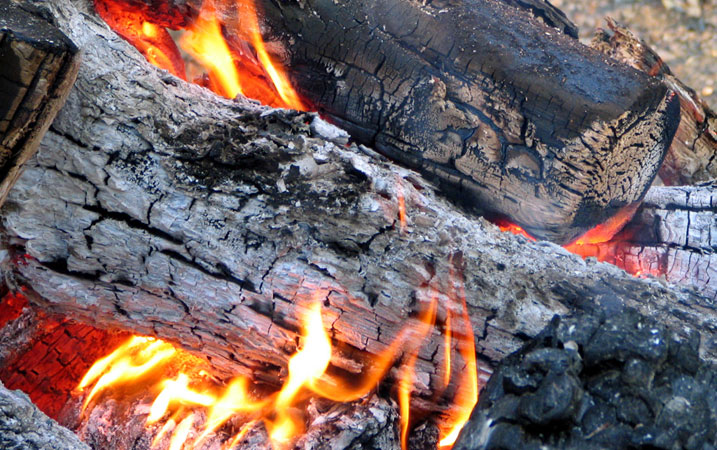Bending our days to the building of good fires
He was out there before I was on a frigid January morning, loading firewood from his barn to the back of his truck. I trotted over, guilty of having overslept. It was 7:30 and the agreed-upon-time had been an hour ago. He is a country man, a father and a teacher, and he was doing me a favor. I’d equipped a barn with a wood-burning stove, but had no clue how to make it work. He sold wood on the side, extra income for his family — beautiful cords that he split himself, and he’d offered to take part of his precious Sunday morning to stock me up.
I followed his instructions: found a plastic sled, waited for his truck to pull up with the wood. Together we slid and carried it down the frozen hill, stacked it in a spot he thought best, then went out to look at the brilliant winter sky. An hour had passed.
“What do I owe you,” I asked when we were done.
“Don’t worry about it,” he answered. “See how much you burn in the next few days and we can take it from there.”
After four tries, I got a fire going. Between stints at my work, I‘d sidle over like a new mother and peer in. Did it need another piece of wood? Should I open the vents wider, or close them down? I learned a lot about stove fires that first day. I learned that once a fire is concentrated, its capacity to create heat boosts exponentially. It took an hour to climb from 39 degrees into the mid-40s. But once there, the thermostat hurtled to 60 in under half an hour.
My grasp of physics is poor, but my experience of life is not. A small blaze, well-laid, whether in time or relationships, will come to warm many times larger a space than we imagine. By the time the sun fell below the trees and it was time to head back to the house, I found it hard to believe that all that heat would sink back to nothing, or that come morning, I would arrive to just a pile of ash.
My neighbor gave two hours of a Sunday to provide me with wood, and the wood in turn gave its capacities to warm my barn. Sacrifice in the service of transformation. In the process of this exchange, my neighbor also set down a small and gracious warmth between us, two people who didn’t, until that encounter, know much about one another. As we loaded and carried wood, I learned that he taught in a country school where more than 75 percent of the kids are on government-supported meals, and where the boys own, at best, two shirts to their names. They rotate these through the course of every school week, year in and year out, until they fall apart. I learned that he rummages through his own closet to find anything he might pass along. Behind the woodpile and the pickup truck, I discovered a man of generosity, authenticity, and inner strength.
The next morning, the stove indeed presented me with a cold pile of ash.
I returned to my city home and the start of Lent with new eyes. It is a true and good exercise on Ash Wednesday to remember our radical contingency. But with the inauguration of my wood stove, I approach this Lent seeing more clearly the way in which grace is released every time we willingly die a little, the way my neighbor did — to his Sunday morning coffee in his robe and slippers by his own fire, before everyone was off to ski lessons and church services. There is an inexorable equation to love and justice: Until we give to strangers, until we die enough to ourselves to give to strangers, we are unformed, mere children of the spiritual life.
But there was something more in his kindness. In it I read what I felt was an important key — our “renderings” are blessed when they are the gift not of duty or convention, but of our authentic selves. Coercion and gender roles too often blight the concept of sacrifice. In this, organized religion has sometimes harmed as much as it has honored. The demands we make on others by virtue of guilt, or our ability to dominate or oppress, have no place in the equation of sacrificial love. That kind of giving, often in kindness and quietly, does just the opposite of diminish us. Through it, we give off the heat and light of who we are called to be. In this kind of dying, we become.
Somewhere out in the cold expanses of my northern winter, loons and herons are battened down waiting out the cold. Behind the bright blue canopy, the stars are racing toward their own version of ash. Nothing we are watching, rejoicing, or agonizing over — whole villages without food or water for going on a year because of warring bands of angry men; helpless children brought into the world and subjected to disintegrating parents, cold cereal for supper if they are lucky, beatings, starvation, and rape before social service agencies bat an eye, politicians shading the truth or bellowing obscenely polarizing rhetoric — none of this will remain. Even the temple, we are taught, will be destroyed.
But what of goodness itself? Does goodness leave a residue, a kind of body double, to the conditions that it has left gladdened, blessed, and warmed a bit by its light? Doesn’t even the smallest kindness effect a resurrection of the spirit? When I peered into the stove at the morning’s mound of ash, I saw the shadow forms of the logs that had burned there. I was, and am, still warmed by the gift of my neighbor. Without him, none of it would have happened. In the same way, I am warmed by those who have touched my life with love, each in their singular magnificence. Just like the Apostles saw Jesus — everywhere, it seemed — for a time.
As Lent begins, I want to imagine what our own small fires can warm and change, on these blink-of-an-eye journeys we are each on, before we turn to ash. In the midst of the world’s infernos and bonfires, how can I bend my days to the building of good fires, of warmth and welcome. This would seem to be the sacrifice — the blessing — that matters.





No Comments